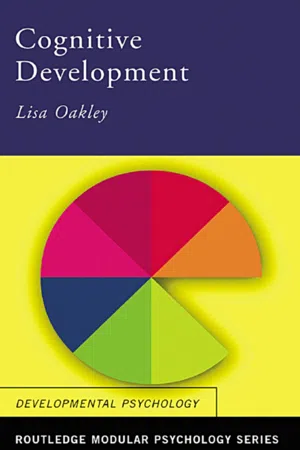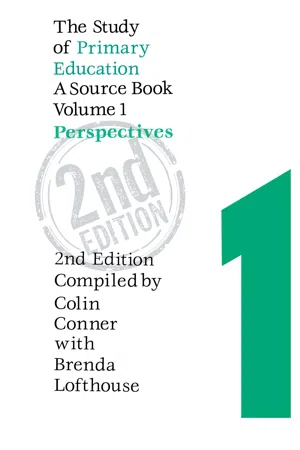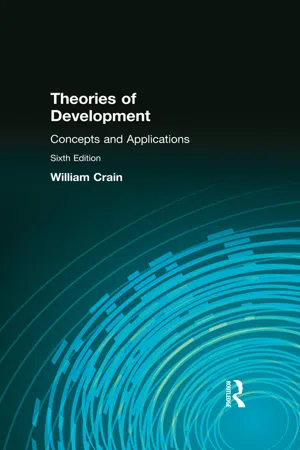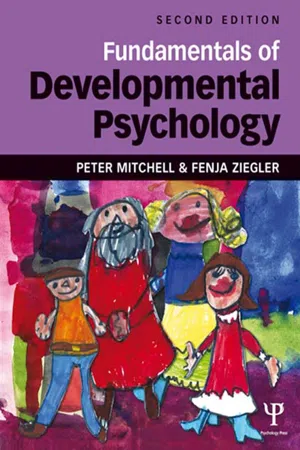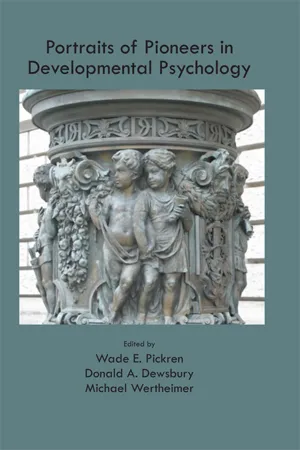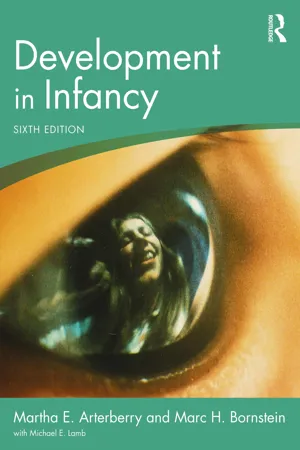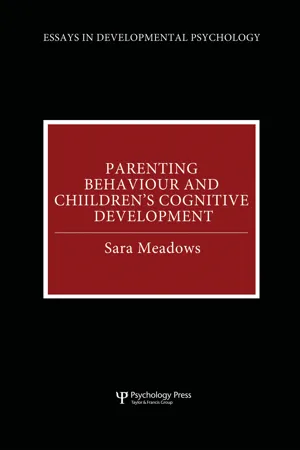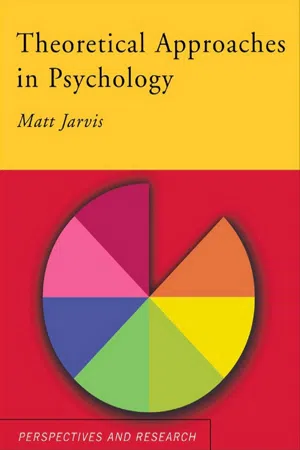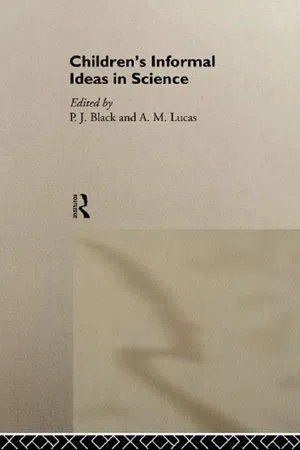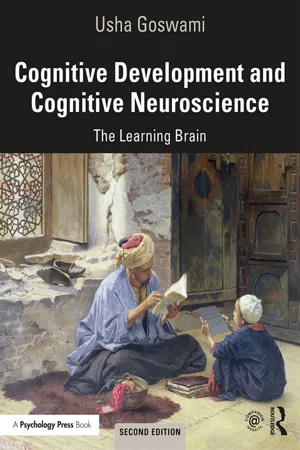Psychology
Piagets Theory in Education
Piaget's theory in education emphasizes the importance of active learning and the role of cognitive development in the learning process. It suggests that educators should tailor their teaching methods to match the cognitive abilities of students at different developmental stages. This approach encourages hands-on learning experiences and promotes the development of critical thinking skills.
Written by Perlego with AI-assistance
Related key terms
Related key terms
1 of 4
Related key terms
1 of 3
12 Key excerpts on "Piagets Theory in Education"
- eBook - ePub
- Lisa Oakley(Author)
- 2004(Publication Date)
- Routledge(Publisher)
2Piaget’s theory of cognitive development
Introduction
The study of cognitive development is dominated by the theories of two key psychologists – Piaget and Vygotsky. Other theories have been developed but they usually have foundations based upon these key theories.Jean Piaget (1896–1980) was one of the most influential theorists in the field of cognitive development. Piaget was a philosopher, biologist, educationalist and psychologist. He made the decision to study scientifically the way in which children develop knowledge.It was Piaget who first noted that children were not just miniature replicas of adults, but in fact were different in the ways in which they thought about and interpreted the world. Piaget’s idea was that adults did not simply know more than children, but that their knowledge was structured differently. Indeed, Piaget suggested that children at different stages of their development thought about and interpreted their worlds in different ways (Hummel, 1998). Piaget developed the idea of children as ‘ “little scientists” who were engaged in active exploration, seeking understanding and knowledge’ (Bee, 2000:164).Principles of Piaget’s theory
Piaget’s theory of cognitive development was based on three main principles – those of assimilation, accommodation and equilibration. These will be explained below, however, first it is important to define the term ‘schema’.Schema is a cognitive representation of activities or things. When a baby is born it will have an innate schema for sucking in order to ensure that it can feed and therefore grow. As the baby grows this schema will become integrated with other feeding schemas as the baby’s experience and nutrition changes.Assimilation - eBook - ePub
The Study Of Primary Education
A Source Book - Volume 3: School Organization And Management
- Colin Connor, Brenda Lofthouse(Authors)
- 2020(Publication Date)
- Routledge(Publisher)
As Piaget’s work has been popularized and simplified, it has often been misinterpreted, taken out of context of his overall view and prematurely applied. Piaget’s formulation is not easy to understand. In formulating his theories Piaget draws models and synthesized information from the fields of biology, mathematics, philosophy, physical sciences, and psychology. Therefore, a knowledge of the major concepts in these fields is essential and a knowledge of French is helpful to grasp fully Piaget’s theories.[Adide then goes on to indicate the main elements of Piaget’s ideas in terms of their significance to education.]Assessing Student’s Cognitive Levels
In order to adjust his teaching strategies to the class as a whole, and to plan for appropriate activities to meet different individual needs, a teacher utilizes various diagnostic techniques to assess his students’ conceptual level. As the experienced teacher knows, not all of these techniques are effective.Piaget has made two important contributions, one theoretical the other practical, to help the teacher in this assessment (a) by delineating four critical stages of development which the teacher can look for in his studies, and (b) by providing a simple but effective clinical method of listening to student’s errors so that their appropriate level of development can be assessed.Piaget’s Developmental Stages
Piaget describes intellectual development as evolving through various stages in the individual development of the child. In Piaget’s words: ‘development is achieved by successive levels and stages’,3 each of which lays the foundation for its successors. The four most important stages he recognizes are now well known: the sensory-motor stage, the pre-operational stage, the concrete operational stage, and the stage of formal operations. [Detail of these stages is provided in the previous extract by Isaacs (pp. 283-8).]Let us note he writes that these stages are precisely characterized by their set order of succession... That is, in order to reach a certain stage, previous steps must be taken, and the prestructures which make for further advance must be constructed.4 - eBook - ePub
Theories of Development
Concepts and Applications
- William Crain(Author)
- 2015(Publication Date)
- Routledge(Publisher)
Fifth, Piaget, like other rigorous stage theorists, claimed his stages unfold in the same sequence in all cultures. This proposal frequently puzzles readers. Don’t different cultures teach different beliefs, particularly with regard to morals? We will take up this issue in the next chapter, but in general the Piagetian answer is that the theory is not concerned with specific beliefs but with underlying cognitive capacities. So young children, regardless of their cultural beliefs on matters such as sex or fighting, will base their views on what they think authority condones or punishes. It is not until adolescence, when young people acquire formal operations, that they will give abstract, theoretical treatises on moral matters, whatever their specific beliefs.In summary, then, Piaget advanced a rigorous stage theory, which means he believed his stages (1) unfold in an invariant sequence, (2) describe qualitatively different patterns, (3) refer to general properties of thought, (4) represent hierarchic integrations, and (5) are culturally universal.Movement from Stage to Stage
Piaget devoted a great deal of attention to the structures of his stages and far less attention to the problem of movement through them. Nevertheless, he had definite views on this topic.He acknowledged (1964b) that biological maturation plays some role in development. For example, children probably cannot attain concrete operations without some minimal maturation of the nervous system. However, Piaget said that maturation alone cannot play the dominant role because rates of development depend so much on where children live. Children who grow up in impoverished rural areas frequently develop at slow rates, apparently because they lack intellectual stimulation. The environment is also important.However, it is easy to exaggerate the role of the environment, as learning theorists do. Generally speaking, learning theorists believe the child’s mind is primarily a product of external reinforcements and teaching. Piaget-ian concepts, they assume, must be taught by parents, teachers, and others. However, it is not at all clear that this is the case, as we will discuss in the last section of this chapter.In Piaget’s view, the environment is important, but only partly so. The environment nourishes, stimulates, and challenges the child, but children themselves build cognitive structures. As children seek out the environment, they encounter events that capture their interest - eBook - ePub
- Peter Mitchell, Fenja Ziegler(Authors)
- 2013(Publication Date)
- Psychology Press(Publisher)
Not everybody is in agreement about the way children understand the world, and how that understanding develops. This is mainly because what children say and do is open to interpretation with respect to the implications for their level of competence. For example, a commonsense explanation for young children’s difficulty in communicating on the telephone might simply say that their lack of experience has not allowed them to develop a suitable “telephone manner.” If this were true, the problem would not be attributable to the child’s immaturity, but to lack of practice. By the same token, an adult who had little experience of using telephones would be equally poor at communicating. Cognitive developmentalists thus look for independent evidence to support their suggestion of children’s immature understanding. The result is that cognitive developmentalists who hold different opinions try to present evidence and argument to show that their theory is compelling.The most interesting aspect of cognitive developmental psychology is, of course, making discoveries about how children understand the world. But there is also an interesting subplot surrounding the discovery process itself. The interest in this process is stimulated by some ingenious tasks which have been presented to children in order to investigate their thinking, coupled with some brilliantly insightful arguments that have been developed in support of particular ideas about the character of children’s understanding. The purpose of these arguments is to persuade us to accept one view of children in preference to a competing one.In the following pages, we begin by looking at some of the findings and ideas of the most influential cognitive developmentalist, Jean Piaget. We will consider some criticisms of Piaget’s conclusions, and then examine subsequent findings and ideas that were offered in the post-Piagetian era. Piaget proposed that children negotiate a succession of stages en route to maturity, and the following provides a summary.Stages of Cognitive Development
Piaget indicated age ranges for the stages, but these were only intended to be approximate. The more important feature is that the order of stages is supposed to be fixed and invariant, based on the assumption that each stage served as the foundation for the next; so, according to the theory, it would be impossible to miss a stage. To Piaget, missing a stage would be akin to building the second storey of a house without first building the first storey. Consider an example more relevant to the development of thinking: It is very hard to imagine how you could do long multiplication without first being able to do addition. According to Piaget’s theory, then, progressing through one stage is a prerequisite for progressing to the next. Still, if you enjoyed the benefit of appropriate experiences, it might be possible to progress through the stages more rapidly than someone less fortunate. Later, we will consider what kind of experiences might be beneficial. The stages are summarized in the table below. - Wade Pickren, Donald A. Dewsbury, Michael Wertheimer(Authors)
- 2012(Publication Date)
- Psychology Press(Publisher)
6Jean Piaget:Theorist of the Child’s Mind
BERNARD C. BEINSIthaca CollegeJean Piaget (b. August 9, 1896, d. September 16, 1980) has had more influence on the study of cognitive development than any other psychologist. As soon as his first books appeared, psychologists recognized the fertility of his ideas, even though those ideas had to make a linguistic journey from French to English, a translatlantic journey from Switzerland to the United States, and a methodological journey from more philosophical to more psychological. Piaget’s theory of cognitive development continues to dominate developmental psychology over 80 years after its introduction.Figure 6.1 Jean Piaget. (Courtesy of the Jean Piaget Society. With permission.)Piaget’s background mirrored that of the earliest generation of psychologists in his combined focus on the natural sciences and philosophy. Piaget credited his early work in the natural sciences with keeping his focus scientific, but he also maintained a European flavor to his ideas with a greater attachment to philosophy and logic than was common among psychologists in English-speaking countries at the time.Even with the shared background, however, Piaget developed his ideas largely independently of mainstream experimental psychology of the 1920s, which was already being led by English-speaking, behaviorally oriented psychologists in the United States. Piaget’s empirical approach was called “clinical,” relying on small samples and attention to children’s verbal statements to provide insights into cognitive processes. This approach was at variance with American psychology in that the latter had moved away from the study of mental processes that featured so prominently in Piaget’s work. In addition, whereas Piaget tended to study small numbers of children, American psychology had moved toward studying groups, averaging out the effect of unusual behaviors that might have been of great interest to Piaget. The few structuralists of Edward Bradford Titchener’s bent who remained active in psychology in Piaget’s early years would not have studied children because of the children’s relatively limited verbal skills. Their inability to report their introspections would have ruled them out as experimental participants.- eBook - ePub
- Martha E. Arterberry, Marc H. Bornstein(Authors)
- 2023(Publication Date)
- Routledge(Publisher)
equilibration process because it represents a crucial aspect of adaptation that is brought into play to resolve contradictions between children’s scheme-based comprehension of the world and the reality in which children live. Piaget was primarily interested in processes whereby mental equilibrium at more and more reality-based levels can be attained.KEY TERMSEquilibrationa balance in adaptation between the child’s comprehension of the world at any given stage and the reality of the worldAction as the Basis of Knowledge
Piaget contended that knowledge begins with action and that acquiring knowledge depends on doing rather than observing passively (although we know that observational learning does often occur). Thus, Piaget was a “constructivist” in that he believed that individuals actively build their own development. Piaget’s influence is evident in our book’s frequent stress on the active role infants play in shaping their own development (see also Arterberry & Kellman, 2016 ; Lerner, 2018 ).KEY POINTS- According to Piaget, infants learn about their world through interacting in it
- These sensorimotor experiences allow infants to enact and modify schemes through a process akin to adaptation
- As infants encounter new information they incorporate it into their existing scheme (way of thinking), called assimilation, or they modify their way of thinking in light of this new information, called accommodation
What features characterize stages of infant development?
Perhaps the best-known feature of Piaget’s theory is his doctrine of stages. Piaget hypothesized that mental development unfolds in an invariant sequence of cognitive developmental periods. As a whole, infancy encompasses a sensorimotor period - Sara Meadows(Author)
- 2013(Publication Date)
- Psychology Press(Publisher)
The big divide, I think, is between those models where development is largely asocial and predominantly endogenous, and those where it is socially constituted or exogenous. There is a basic philosophical divide here which places Hegel on one side and Kant on the other (see, e.g. Markova, 1982); or, in contemporary work, at one extreme we have nativist theories postulating innate ideas (e.g. Fischer & Bidell, 1991; Fodor, 1981, 1983; and see also Plomin, 1994b; Plomin & McClearn, 1993) and at the other we are essentially constituted by our society (e.g. Bronfennbrenner & Ceci, 1993; Mayall, 1994). Most developmental psychologists agree that "cognitive development" involves change from a starting point which includes some innate predispositions, if not ideas, towards later states which vary in their content and in their sources, and that this change comes about largely through an active engagement of the individual with the physical and social worlds; however, emphases within this general agreement differ considerably. The debate in the psychology of cognitive development is embodied in the work of Piaget and Vygotsky. Each acknowledged that cognitive development is both endogenous and influenced by the outside social world, and each admired the other's work even when there were disagreements, but they developed different emphases, particularly regarding the role of adult-child interaction in the development of the child's cognition (Glassman. 1994; Van der Veer & Valsiner, 1991). I will outline their theories in turn. Piagetian theory has been understood as marginalising the role of adults in children's cognitive development, and so might be judged to be irrelevant to this essay, but an understanding of this child-centred approach is essential for an appreciation of the strengths and the problems of theory which takes the alternative approach and centres on adults' contributions to children's cognition.Piagetian Theory and Adult-Child Interaction in the Development of the Child’s Cognition
Piaget emphasised the biological nature of cognition, seeing it as one form of the general struggle for "adaptation" to the environment which is characteristic of all living organisms and at the heart of evolution, with the motive forces for this struggle being seen as predominantly endogenous. The Piagetian organism owes its development primarily to an innate and inevitable drive to adapt to its environment, through assimilating new information to the structures of knowledge which have already developed, and accommodating its existing structures of knowledge to accumulating new information. It is equipped with a need to "equilibrate"; that is, to maximise consistency, to eliminate contradiction and to ensure coherence in what it knows. It develops through equilibration's orchestration of three disparate things: physical maturation, primarily of the brain; reflection on its experience of the physical world and of the logical rules which can be applied to it; and finally and marginally, social interaction. The last factor is the least emphasised in Piagetian theory. The main form of social interaction which he saw as contributing to cognitive development was conflict with one's peers. This could lead to a recognition that one's own ideas were disagreed with by someone like oneself, and therefore might potentially be disagreed with by oneself too. (Equilibration is also, and more importantly perhaps, driven by the recognition that one actually disagrees with oneself, in an entirely endogenous cognitive conflict.) This recognition of a potential internal conflict is what prompts further reflection, and the revision of old ideas. Piaget (1932, 1968, 1983) implied that disagreement with someone unlike oneself would not have this effect of sparking off an internal disagreement, because it would not be recognised as potentially one's own problem. Disagreement with an adult, especially correction by an adult, would have little benefit for true cognitive development both because adults are viewed as different by children and because the power difference complicates things; the Piagetian child may bow to the adult's authority to the extent of parroting the correction, but will not internalise it. The result of adult instruction in the Piagetian model is limited; it gives rise to passive copying of what the adult has said is right, which does not become integrated with what the child has worked out independently, and may be even more damaging in that it may prevent the child from discovering for him or herself what the adult has taught.- eBook - ePub
- Matt Jarvis(Author)
- 2005(Publication Date)
- Routledge(Publisher)
qualitatively different—i.e. children simply do not think in the same way as adults.This idea was extremely radical when Piaget started out, but it has now become generally accepted in cognitive-developmental psychology. In fact you may regard this as common sense. Piaget was interested both in how children learnt and in how they thought. We can have a look at these issues.How children learn
Piaget saw intellectual development as a process in which we construct an internal model of reality. In order to gain the information to construct this internal representation of the world we spend much of our childhood actively exploring ourselves and the outside world. You may have noticed that even very young children are inquisitive about their own abilities and about their surroundings. Piaget proposed that the child’s mental world contains two types of structure, schemas and operations.Schemas
Schemas are packets of information, each of which relates to one aspect of the world, including objects, actions and abstract concepts. Piaget believed that we are born with a few innate schemas which enable us to interact with others. During the first year of life we construct other schemas. An important early schema is the ‘me-schema’ which develops as the child realises during its first few months that it is a separate object from the surrounding world.When a child’s existing schemas are capable of explaining what it can perceive around it, it is said to be in a state of equilibrium. However, whenever the child meets a new situation that cannot be explained by its existing schemas it experiences the unpleasant sensation of disequilibrium. We are all instinctively driven to gain an understanding of the world and so escape disequilibrium. Piaget identified two processes by which equilibration takes place: assimilation and accommodation. - eBook - ePub
- Ernst von Glasersfeld(Author)
- 2013(Publication Date)
- Routledge(Publisher)
Chapter 3Piaget’s Constructivist Theory of KnowingIt is a difficult task to glean a coherent theory of cognitive development from Piaget’s enormous body of work. Over a period of seventy years, Piaget published eighty-eight books, hundreds of articles, and edited countless reports of research that had been carried out under his supervision.1 His thinking and his ideas never ceased to develop, to branch out, and to spiral into new formulations which, in his mind, continuously expanded and modified what he had expressed in earlier writings. As a result, it requires considerable effort to sort out what seems to have remained the same and what was modified in the course of those decades. Those who venture to summarize Piaget’s ideas on the basis of two or three of his books have a limited perspective. They inevitably remain unaware of implications that cannot be grasped except from other parts of his work. Unfortunately, there are countless psychology textbooks and critical journal articles that fail in this respect. At best they provide an incomplete view of Piaget’s theory, at worst they perpetuate distortions of his key concepts. Many summarizers and critics, moreover, seem to have missed, or simply disregarded, the revolutionary approach to epistemology that Piaget developed as the basis of his investigations. This second failing is the more serious. Without the understanding that Piaget quite deliberately stepped out of the western philosophical tradition, it is impossible to come to a comprehensive view of his theory of knowing and the model he built to explain how children acquire knowledge.Piaget is not easy reading. Although he never ceased to praise the virtue of ‘decentration’ — the ability to shift one’s perspective —, he himself, as a writer, did not always try to put himself into his reader’s shoes. I feel that writing often was for him, as for many original thinkers, part of working out his ideas for himself. His untiring efforts to express his thoughts in the greatest possible detail do not always help the reader’s understanding. Yet, I never doubted that it was worth trying to overcome those difficulties, for the effort has led me to a view of human knowing that no other source could have provided. - eBook - ePub
- P. J. Black, A. M. Lucas(Authors)
- 2002(Publication Date)
- Routledge(Publisher)
From a methodological point of view, Piaget established a tradition. He went into schools and talked informally to children; he usually devised some interesting activity or task for the child to do as the focus of the conversation; but above all he listened to and valued what children said. This approach, known as the clinical method, has now been widely adopted, but unfortunately is sometimes not carried out with as much care as Piaget himself insisted on.Epistemological concerns were the focus of Piaget’s work and not psychology for its own sake. His essential quest was to understand knowledge—what it is and how it develops. More than this he wanted to know what types of knowledge were essential to our view of reality, with each of these informing an area of research. So Piaget’s main concern was to trace how these various areas of knowledge developed, with children illustrating development rather than speaking in their own right. Thus much of his research describes in detail children’s reactions to many hundreds of ingeniously conceived tasks within specific knowledge domains: for example, number, space and geometry, and physical quantities, to name only a few.Fundamentally what Piaget’s work showed was that children’s ideas about the world are importantly different from those of the adult, and certainly from those of the science teacher, and that if ‘knowledge’ is so evidently an evolutionary process, then all the stages leading up to it must be vital to the child. Thus the way in which children understand the world at any given moment, though to adults it may appear wrong, or strange, or even childish, is of great importance to them. Each new step in understanding is a necessary phase in its evolution; each new insight is like a springboard to the next stage.Piaget was interested in universals, in knowledge that was common to all individuals and in structures that would allow him to hypothesise mental links between very different conceptual domains. For Piaget, an individual’s thinking about reality was determined by his or her present mental structure.It is crucial to distinguish between the idea and discovery of structure and the way in which it is formalized. Many, not satisfied with Piaget’s structural models, have shown that they are not adequate representations of thinking. Such criticisms do not argue against structuralism but against the particular model chosen. Research is still going on around the issues of the nature of development, and problems of discontinuity or continuity. - eBook - ePub
Theories of Human Development
A Comparative Approach
- Michael G. Green, John A. Piel(Authors)
- 2015(Publication Date)
- Psychology Press(Publisher)
These include biological maturation, physical experience, and social experience. The fourth factor, equilibration, is the most important because it regulates the other three and is the primary reason his theory is classified in the constructivist paradigm. Biological Maturation. Biological maturation, especially the growth of the nervous system, sets the maximum limits of development. It produces new possibilities for cognitive construction but does not predetermine intellectual abilities per se (note in the previous section that not everyone reaches the formal operational stage of development). Consequently, maturation provides a necessary but not sufficient condition for cognitive progress. In other words, development could not occur in the absence of maturation, but neither can it be wholly explained by maturation. Experience. Experience contributes a worldly context of sensations within which cognitive constructions become adapted. But, according to Piaget, there are two kinds of experience, analogous to the operative–figurative distinction described earlier. Physical experience consists of behavioral or perceptual sensations we derive from objects and events, and these sensations result in figurative knowledge. It is important to note that children do not obtain physical experience by simply reading their sensory impressions like a camera. Rather, all actions are accompanied by some degree of assimilation (distortion and meaning making) to prior cognitive structuring. Object permanence, for example, is dependent on the schemata previously constructed by the infant, and lacking a schema of the permanent object, an infant will be unable to derive “permanence” from its own physical experiences. In contrast, logico-mathematical experience is produced by the coordination of one’s actions (whether mental or physical) on objects or events - eBook - ePub
Cognitive Development and Cognitive Neuroscience
The Learning Brain
- Usha Goswami(Author)
- 2019(Publication Date)
- Routledge(Publisher)
Developmentally, therefore, sensory-motor cognition does not seem to be redeveloped in the mental realm, as Piaget argued. Instead, the crucial factors in explaining development appear to be the augmentation of sensory-motor knowledge by increasing experience, some of which is active and some of which is transmitted by language (discussed below). Logical development is more likely to depend on the ability to reflect on one’s knowledge (metacognition), and efficiently to inhibit competing knowledge that is interfering with the application of logic (an executive function). With developments in metacognition and executive function, children can apply concepts like transitivity and invariance in a strategic way to new situations. Houdé (2000) offers an interesting example of this framework for explaining cognitive development that is based on inhibition. Thoughtful treatments of Piaget’s theory that disagree with the arguments given in this chapter can be found in Chapman (1988) and Smith (1992, 2002).Formal operational thought
KEY TERM
Formal operational thought
content-type="flushleft">The ability to take the results of concrete operations and to generate hypotheses about their logical relationships, for example applying a formal system such as propositional logic to elementary operations concerning classes of objects and their relations.According to Piaget’s theory, cognitive change beyond the concrete operational period depended on the emerging ability to take the results of concrete operations and to generate hypotheses about their logical relationships. This ‘formal operational’ reasoning became available at the age of approximately 11 or 12 years. Piaget described this level of reasoning as ‘operating on operations’, or ‘second-order’ reasoning:This notion of second-order operations also expresses the general characteristic of formal thought – it goes beyond the framework of transformations bearing directly on empirical reality (concrete operations) and subordinates it to a system of hypothetico-deductive operations, i.e. operations which are possible. (Inhelder & Piaget, 1958, p. 254)Piaget characterised formal operational reasoning in terms of the ability to apply a formal system such as propositional logic to the elementary operations concerning classes of objects and their relations. Again, the underlying idea was that cognitive structures developed to mirror mathematical logic.
Index pages curate the most relevant extracts from our library of academic textbooks. They’ve been created using an in-house natural language model (NLM), each adding context and meaning to key research topics.
Explore more topic indexes
Explore more topic indexes
1 of 6
Explore more topic indexes
1 of 4
